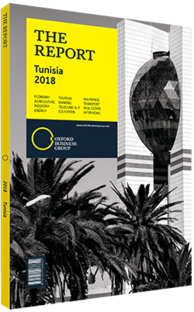Large-scale solar energy project in Tunisia will export electricity to Europe
In an effort to address high energy production costs and increase the use of renewable sources, a delayed project to build Tunisia’s first large-scale solar energy farm is now under way. The farm, set to be developed by UK firm TuNur, was approved in 2012, not long after the country’s revolution. Ongoing political and economic instability led to interruptions in the project’s development, but with an improvement in the security environment, the government and private developer have been taking steps to proceed.
In August 2017 TuNur applied for the government’s authorisation to build the solar plant, which will sell most of its electricity output to European markets. The first phase of the project, estimated to cost €1.6bn, will have an installed capacity of 250 MW and be operational by 2020, according to TuNur. The full project is expected to cost upwards of €5bn and have a total generation capacity of 4.5 GW of electricity per year. Construction of the facility, which is to begin before 2019, will take place in the south-west governorate of Kébili, according to the firm’s plans. Half of the farm will be owned by TuNur, with the remaining 50% dispersed among Tunisian and Maltese investors.
Comparative Advantage
The project will capitalise on Tunisia’s natural conditions for solar energy production. With the Sahara desert covering the majority of the country, Tunisia receives twice the amount of sunlight as countries in central Europe, according to Kevin Sara, the CEO of TuNur. The project is expected to employ concentrated solar power technology to generate electricity, and will rely on the construction of additional underwater cables to transport the electricity to customers in Italy, Malta and France.
The first cable to be completed will be the connection from Tunisia to the island of Malta, which is already linked to the European electricity grid through an existing underwater cable that connects it to the Italian island of Sicily. The 500-km cable between Tunisia and Malta is to be laid by 2021 under the Elmed project, at an estimated cost of €1.6bn. This first link to the European electricity market will be able to transport 250-500 MW of energy. Two additional transmission cables are under consideration as well. One likely option would link Tunisia directly to Italy, while another potential transmission line would allow solar energy to flow to the French electricity grid.
Overcoming Hurdles
The TuNur project follows a recent failed attempt to utilise Tunisia’s portion of the Sahara desert to produce solar power. The Desertec project, which planned to channel €400bn into concentrated solar power generation, was cancelled in 2013 not due to technical or financial reasons, but because of regional instability that affected North Africa after the 2011 revolts. That project was to establish power-generation facilities across 17,000 sq km and eventually produce as much as 15% of Europe’s electricity needs through financing from the EU and private investors.
Although Tunisia’s overall political environment has become more stable in recent years, infrastructure projects across several sectors have faced local protests that caused considerable delays to completion. In 2016 and 2017 protests in the southern regions brought oil and gas production to a halt at the El Kamour oil field. The protests, which focused on the demand for more jobs and the effects of regional development projects, lasted for months. Road construction and water network expansion projects have faced similar delays. Future instability in the south may affect the execution of the TuNur solar generation project as well.
Another challenge may arise from the export orientation of the initiative; the TuNur project is geared towards the production of electricity for Europe. However, given the rise in electricity consumption in Tunisia, the pressure on authorities to accelerate clean energy projects to meet growing domestic demand will likely intensify. In this sense, though, once completed, TuNur may prove a successful template for the future development of large-scale solar generation in Tunisia.
You have reached the limit of premium articles you can view for free.
Choose from the options below to purchase print or digital editions of our Reports. You can also purchase a website subscription giving you unlimited access to all of our Reports online for 12 months.
If you have already purchased this Report or have a website subscription, please login to continue.

